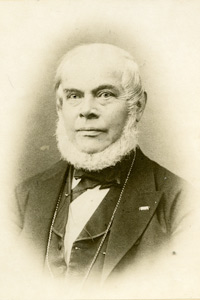In the mid-1800s, Copenhagen suffered from a serious cholera epidemic. This prompted the College of Advanced Technology (now DTU) in 1865 to give lectures on water supply and drainage, which sowed the seeds of an environmental export success.
On 11 June 1853, a 19-year-old carpenter was working on a hopper barge in the Port of Copenhagen. Around noon, he suddenly felt unwell with symptoms such a vomiting and diarrhoea. He was sent home, but shortly after admitted to Nyboder hospital, where he infected other patients. It was not until 12 days after that he was diagnosed with the infectious Asian cholera. The infection quickly spread and turned into an epidemic. The mortality rate among the infected was over 50 per cent.
The doctors disagreed on the origin and routes of transmission. They used the standard treatment methods (blood-letting, enema, and vomiting), which only worsened the patient's condition. Following targeted instructions on proper preventive measures regarding hygiene and partial isolation of the infected, they finally managed to contain and control the disease.
When the cholera epidemic had run its course, focus on sanitation in Copenhagen was increased. At that time, the streets were covered in excrements and waste, there was a lack of sewers, and the drinking water consisted of contaminated surface water from near-by lakes.
Engineers take control
Ludvig August Colding (1815-1888) was the first city engineer in Copenhagen. In 1864, he started working together with the College of Advanced Technology (now DTU). In 1865, he gave a number of lectures on sanitary engineering focusing on waste water treatment (primarily latrines) and drinking water supply. He thus laid the ground for modern sewerage in locked sewers and the separation of waste water and drinking water.
World-leading researchers
Today, this specialist field is managed by DTU Environment, which ranks among the world's leading research institutions in the environmental area. The department collaborates with more than 50 international research institutions and educates environmental engineers from all over the world. The department attracts world-leading researchers, and more than 30 different nationalities are represented among the staff..
Environmental engineers are the foundation of many Danish clean-tech companies providing environmental consultancy services on a global scale. The environmental area is a rapidly growing export market, regarded by the Danish Parliament as one of the major future industries in Denmark.
"Today, waste water is treated and used as high-quality drinking water in many places around the world. But Colding would probably be turning in his grave if he knew about it."
Thomas Højlund Christensen, Head of Department, DTU Environment
According to Head of Department Thomas Højlund Christensen, DTU Environment, this is hardly what Colding envisioned 150 years ago:
"Today, waste water is treated and used as high-quality drinking water in many places around the world. But Colding would probably be turning in his grave if he knew about it," says Thomas Højlund Christensen.
Danish position of strength
According to the UN, 750 million people have no access to clean drinking water, and 80 per cent of the world's waste water is discharged untreated. If this trend continues, 1.8 billion people will not have access to clean drinking water in ten years. The world market for water technology is estimated at approx. DKK 3,000 billion a year and is expected to grow 50 per cent more than the general economy up until 2018. This opens up major possibilities for a country like Denmark. We export water technology worth approx. DKK 15 billion a year.
"Therefore, Danish water technology can contribute to making the world a greener place, while also creating growth in Denmark," says former Minister for the Environment Kirsten Brosbøl.
“We have been doing this for years, so we have the right expertise. This gives Danish companies clear positions of strength." According to the minister, Denmark is known around the world for delivering intelligent and efficient solutions. "For us to maintain this position, we need leading technical universities such as DTU who contribute to arousing an interest among young Danish people in engineering programmes within the field of water," says Kirsten Brosbøl.

Ludvig August Colding (1815-1888) was the first city engineer in Copenhagen. He had previously been working with gas lighting, waste water treatment, and water supply based on subsoil water.
In the period 1865-1883, he gave lectures at the College of Advanced Technology entitled 'The principles for heating and ventilation, discharge of waste water, and the supply of water and gas'. In addition to teaching,
Colding was a significant scientist in physics, thermodynamics, and hydrology, among other areas. Together with Julius Thomsen, chemist and later DTU president, Colding can claim credit for detecting the route of infection of cholera. Furthermore, Colding was the driving force behind the establishment of the Danish Meteorological Institute in 1872.